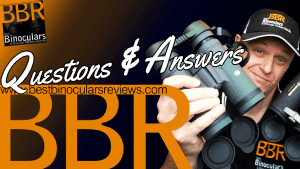

 |
||||||||||||||
|
||||||||||||||
I must admit to having mixed emotions about Zoom binoculars: On the one hand the ability to scan over a wide area using a lower magnification and a wider field of view until you spot the object that you are after and then being able to "zoom" into it and observe all it's details using a higher magnification is in theory an excellent idea. But there are quite a few challenges and drawbacks to this, especially when you try and implement this zooming ability on binoculars. This is mainly because binoculars are effectively two separate telescopes connected together, but each having to be perfectly synchronised so that you get a crisp clear image, this becomes even harder to do when you have a variable magnification..
In the past, I have briefly tried and used quite a few pairs of Zoom binoculars and have had mixed results which has meant that I continue to have fairly mixed feelings about them. But up until now, I have never had the opportunity to fully test and review a pair over a long period of time. So when I was contacted by one of my readers who said that they wanted to send me their own personal pairs of Nikon 8-24x25 EagleView Zoom binoculars, I jumped at the chance as just maybe these would swing me one way or the other. After more than a week of testing, comparing and using them out in the field, you can read my thoughts and full findings on these Nikon EagleView Zoom binoculars below:
I had the silver version to review, but the Nikon EagleView Zoom is available in two other color variations (black or a camouflage edition). The overall design of the body is fairly standard for a compact porro prism binocular but it's styling means that it has a rather modern and somewhat good looking V-shape to the body when looked at from above. In my "medium sized" hands they were nice and comfortable to hold, this is pretty good as some really small compacts can be a little awkward to hold onto.
Build Quality
Whilst I would not expect a low cost binocular like these to have the same build quality as a top of the range pair that costs ten times as much, but I still want them to be tough enough to handle most normal bumps and scrapes and still want them to feel like you have a good quality optical instrument in your hands and not just a toy.
I could not find any details as to exactly what the interior frame or the exterior body is made of, but the exterior looks to be made from some sort of hard plastic. Nikon state that they have added a carbon fibre material in parts of the grip which they say enhances durability. I am guessing that this is in the parts of the barrels that have a thin dark grey rubber coating on them, which you can see as being the dark sections on the image below:
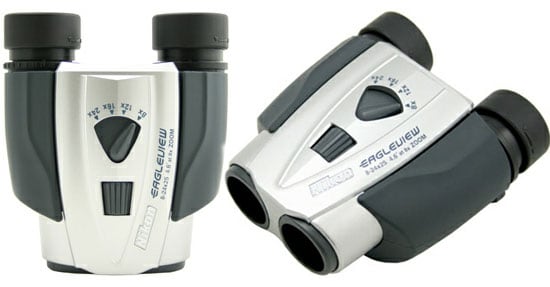
I doubt if this very thin rubber armouring would protect the optics very much from damage, but it does make a nice grippy surface to hold onto and is well placed for this.
Binoculars that are completely covered in a non reflective rubber coating will help to make them less reflective than ones like these Nikon EagleViews that have plenty of shiny silver plastic left exposed that could glint in the sun and frighten away timid birds or other wildlife. If this is a concern to you then you may consider getting the black or even camouflaged version or if it is a major concern, consider choosing a fully armored binocular.
Another downside to them not being fully covered in rubber is that there is more chance of them making a louder sound if something like your watch or more commonly a ring on your finger strikes against them. Rubber armour dampens down the sound and helps to ensure that you don't frighten away easily spooked animals like birds or deer.
But other than these minor points, I would say that as you would expect of any Nikon product, they look pretty well made and considering that they have a plastic shell, they still feel fairly solid and robust and in terms of build quality are as good as any compact porro prisms found in this price range.
Waterproof & Fog proofing?
There is no mention in any of their marketing of them being either water or fog proof and so I must assume that they are neither. In this price range, not many binoculars are fully waterproof or fogproof and so this is fairly understandable, but it would be nice to know that they were at least a little "weather proof" - anyway I am sure that they would survive a little light rain, but to be completely safe just make sure that you don't get them really wet in very bad weather.
The Eye Cups
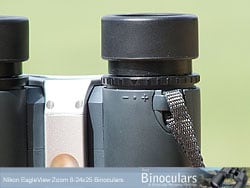 The twist-up eyecups look to be made from a very hard plastic that have a very thin rubber coating on them. The ocular lens has a diameter of 11mm and the eyecup has an external diameter of 37mm, which are both considerably smaller than what you find on most full sized binoculars, but is about average for a compact. This smaller size and very thin rubber covering mean that they are not the most comfortable eyecups that I have ever used, but any discomfort is only really noticeable when you push them quite firmly against your face.
The twist-up eyecups look to be made from a very hard plastic that have a very thin rubber coating on them. The ocular lens has a diameter of 11mm and the eyecup has an external diameter of 37mm, which are both considerably smaller than what you find on most full sized binoculars, but is about average for a compact. This smaller size and very thin rubber covering mean that they are not the most comfortable eyecups that I have ever used, but any discomfort is only really noticeable when you push them quite firmly against your face.
These EagleView Zooms come with a fairly disappointing 13mm of eye-relief, which may be something to keep in mind if you want to use your optics whilst wearing glasses. Ideally and to be sure that you have enough distance to play with to enable you to see the full field of view without any vignetting when using your glasses most experts recommend that you should look for binoculars that have an eye relief of about 16mm or more. In most cases an eye relief of 14 to 15mm is adequate for most people who wear eyeglasses to be comfortable, so 13mm is a little on the short side. Most non-eyeglass wearers will just use the eyecups in the fully extended position.
There are also no fixed intermediate stops on the twist-up mechanism, meaning that if you require a distance in between fully extended and fully retracted, it is a little tricky to keep the cups at that position. The helicoid twist-up mechanism itself works very well and adjusting the cups is simple and very smooth.
Diopter Adjustment
The diopter adjustment like most binoculars is a ring located on the right barrel just under the eyecup and is used to correctly set up and focus the binoculars to your particular eyesight and only really needs to be done once when use them for the first time, unless the setting is moved accidentally or you share your binoculars with someone who's setting is not the same as yours.
On the pair that I tested, the ring was not that tight and there is no locking system, so it could quite easily be moved accidentally. There is a marking on the body of the binoculars, that when lined up with the arrow on the ring let you know where the neutral point is. If your eyesight requires that you need to have it positioned anywhere other than this point, I would suggest making your own mark on the binocular in your specific location so that if it is moved accidentally, or if you share them with someone, you can very easily return it to your correct setting.
Focusing
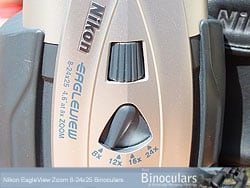 The small focussing wheel is located a little further forward than what I am used to, this is done to accommodate the magnification adjustment dial, which sits just behind it. The wheel itself is nicely grooved and on the pair that I tested turned easily and very smoothly. Like many compacts the wheel is small and partly hidden within the body, this is fine most of the time, but if it is very cold and you are wearing thick gloves, it can make adjusting the focus a little more tricky.
The small focussing wheel is located a little further forward than what I am used to, this is done to accommodate the magnification adjustment dial, which sits just behind it. The wheel itself is nicely grooved and on the pair that I tested turned easily and very smoothly. Like many compacts the wheel is small and partly hidden within the body, this is fine most of the time, but if it is very cold and you are wearing thick gloves, it can make adjusting the focus a little more tricky.
The focusing mechanism is geared so that it takes a full 2 and 1/4 turns to go from infinity to it's minimum focusing distance of 13.1ft (4m).What this means is that focusing from near to far (or vise versa) takes a little longer than ones that take less turns, but it does have the slight advantage of making fine tuning your focus just that bit easier and more accurate. I think Nikon have got this about right with these as it really helps you to get the correct focus when you have the magnification at the higher settings like it's maximum of 24x.
Inter-Pupillary Adjustment
This Nikon compact has, what I think are actually two hinges (it is hard to see as they are located under a cover), with both hinges located very close to each other, meaning that they almost work like single a central hinge design. Whatever the case, the two barrels can be brought closer together or pulled further apart to match the distance between your eyes (Inter-Pupillary Adjustment) by opening or closing the hinges. This adjustment felt smooth and there was the right amount of friction to prevent them from opening or closing too easily, but not too much so as to make moving them difficult. The minimum distance between the centers of the two eye-piece lenses that can be achieved is 56mm when fully folded and the maximum is 72mm when full opened.
Zoom (Magnification) Adjustment
The zoom adjustment dial is easy to operate and you just push it back and forward to zoom in or out. It is also well positioned and adjustments to the zoom levels can be made without having to remove the binoculars from your face, or change your grip.
Best Binoculars Rating for Body Construction Quality: 5/10
Weight and especially size really matter in a good pair of compacts and obviously we are looking for a pair that is as small and lightweight as possible. This is because if the "compact" pair is too large to suit your specific requirements, you may as well just go and get yourself a similar quality mid or full sized pair of optics that by their very design will usually perform better, especially in low light conditions:
Weight
At 350g (12.3oz), it must be said they are on the heavy end of the scale when compared to most other compacts, they do however still feel very light compared to most standard full sized binoculars.
Dimensions
With their eye-cups fully retracted, they have a length of 11.9cm (4.7in), this increases to 12.4cm (4.9n) when you fully twist out the eyecups. Fully folded, the width of the binocular is 9.2cm (3.6in), fully opened it is 11cm (4.3in). Their height is 6.3cm (2.5in), which once again all on the larger end of the scale for a full compact binocular but nothing excessively so.
An important thing to consider when looking at the size of a compact binocular is how small they are when they are folded. When you are are looking through them, just how small they are is not that important, but size is far more important when you carrying them around with you. Different designs of compacts fold up in different ways and this can make a big difference is their size.
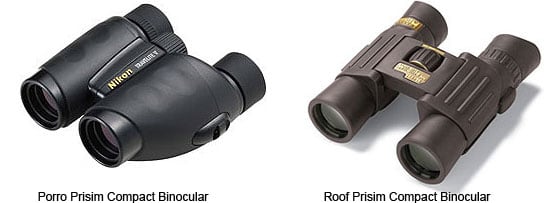
As you can see from the image above and because of the differences in the design of the prisms, compact roof prism binoculars are often more streamlined than porro prisms ones like this Nikon EagleView. When folded this difference can be even bigger when a compact roof prism binocular uses a "duel hinge" design like the one one the right in the image above. The disadvantage of a roof prism however is that it is far harder (and more costly) to make a quality binocular with this type of prism and therefore if you are looking at buying a budget compact like these, you usually get much better performance (optically) with a porro prism, but have to sacrifice a little on the size. For more on this take a look at this article on the Best Compact Pocket Binoculars.
BBR Rating for Body Stats: 6/10
Lens & Prism Coatings
As you would expect on a low cost compact, these don't come with a vast array of expensive coatings and things like super high quality extra-low dispersion glass, but because they are a porro prism binocular their prisms have total internal reflection and as such they do not need some of the coatings that roof prism's do to achieve the same quality of image. This is one of the main reasons why you often get a better performance from a low cost porro prism binocular than that of a roof prism one in the same price range.
To minimize reflection on the lens surfaces and ensure clear, sharp images, anti-reflective coatings are often applied. These anti-reflection coatings are very important as part of the light that passes through any lens is reflected by the front (incident light) and rear (exiting light) surfaces. This reduces the amount of light passing through the lens and if this transmittance is very bad, the image you see will be darker than on binoculars that transmit more light. Also, the reflected light may cause ghosting and flaring, affecting image contrast.
The lenses on these Nikon EagleView Zooms are multilayer-coated. What this means is that they have received multiple layers of anti-reflective coatings which helps to increase light transmission, for a brighter image and therefore better low light performance. This is good, but it would have been even better if they had been fully-multi coated, which would mean that they had multiple layers of anti-reflective coatings on all air to glass surfaces and not just some of them as these are.
Best Binoculars Rating for Optical Components Quality: 5/10
Field Of View (FOV)
When set to a magnification level of 8x, their field of view is 80m at 100m / 240ft at 1000 yards (4.6°) - which, for a what at this setting effectively an 8x25 binocular is not very good. To put this into context, the Steiner 8.5x26 Wildlife Pro has a FOV of 333ft at 1000 yards and the Kowa 8x25 BD has a FOV of 331ft at 1000 yards and even the Minox 10x25 BV BRW which has a magnification of 10x has a FOV of 290ft at 1000 yards.
As you increase the magnification level and zoom in on an object, the FOV reduces even further. However this is not as big a problem as I would suggest the best way to use these zoom binoculars is to have them set at 8x to locate the object that you want to observe and the once you have it in your field of view, you can then zoom into it to get a more detailed view.
Close Focusing Distance
With these Nikon binoculars, the minimum distance that you can focus on an object is a 4 meters (13.1ft) away, which once again is not great and quite a bit further than the best. I consider anything under 6ft to be very good. So if you are looking for a compact binocular specifically for things like observing butterflies then I do not recommend getting these. Rather take a look at these close focusing binoculars.
The 8-24x25 Configuration
At 8x Magnification: All binoculars with an 8x magnification and 25mm objective lenses have an Exit Pupil of 3.13 (25/8) and a Twilight Factor of 14.1, which if you compare them to a full size 8x42 binocular, which has an exit pupil of 5.25 and a twilight factor of 18.3, it shows that the increased objective lens diameter of the 8x42 binoculars will gather more light and make it possible for the binoculars to transmit more light to your eyes. This is the main compromise to using a compact over a larger pair of optics, but having said that in reasonably good lighting conditions like during the day, where your eye pupil size is only about 2 to 3mm, this will not be much of a factor, it is just at twilight and under poor light where you can really notice the difference. You must also remember that having a good pair of compacts even in poor light is still much better than having no binoculars at all!
At 12x Magnification:When you increase the magnification on these Eagleviews to 12x their Exit Pupil reduces to 2.08 (25/12) which means that less gets to your eyes.
At 16x Magnification:When you increase their magnification to 16x their Exit Pupil reduces to 1.56 (25/16) which means that even less light will be getting to your eyes.
At 24x Magnification:When you increased to their maximum level of 24x the Exit Pupil reduces to just over 1 (25/24) which means that not a lot of light that enters the binocular will reach your eyes.
To see this in action, you can hold these binoculars up at arm's length and look at the eyepiece lenses, where you can clearly see the circle of light in the eyepieces, this represents the exit pupil. As you increase the magnification you can actually see this circle of light in each eyepiece getting smaller and smaller - see my series of photos below that I took to demonstrate this:
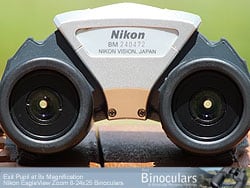 |
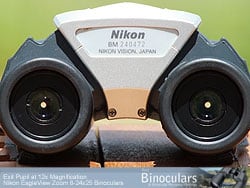 |
| The Exit Pupil at 8x Magnification | The Exit Pupil at 12x Magnification |
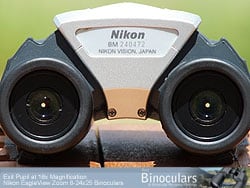 |
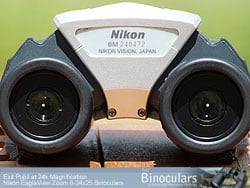 |
| The Exit Pupil at 16x Magnification | The Exit Pupil at 24x Magnification |
You must remember that as well as the Exit Pupil, the performance of a pair of optics in poor light also depends a lot on the quality of the glass and optical coatings and not just the exit pupil and twilight factor formula. Good coatings on the lenses and the prisms can double the amount of light that gets through the binocular, when compared to those that have none or poor quality coatings.
Eye-Relief
These EagleView Zooms come with a fairly disappointing 13mm of eye-relief, which may be something to keep in mind if you want to use your optics whilst wearing glasses. Ideally and to be sure that you have enough distance to play with to enable you to see the full field of view without any vignetting when using your glasses most experts recommend that you should look for binoculars that have an eye relief of about 16mm or more. In most cases an eye relief of 14 to 15mm is adequate for most people who wear eyeglasses to be comfortable, so 13mm is a little on the short side. Most non-eyeglass wearers will just use the eyecups in the fully extended position.
Best Binoculars Rating for Optical Stats: 4/10
As I do for all my reviews, I compared the view through these compact Nikon EagleView 8-24x25 zoom binoculars with that of my control compact binoculars, this is to help me be as objective and consistent as possible:
Image Brightness
Comparing the view through these and that of my control compact, at 8x magnification I would say that in terms of brightness, they were almost equal, which is pretty good and equal to many much more expensive binoculars in this class. As you adjust the zoom and increase the magnification, you can actually see the image produced getting darker and darker, which is to be expected (see exit pupil above). In poor lighting conditions like at sunset, this actually has quite a big impact on just how effective and useful these zoom binoculars are. It may be obvious, but it is for this reason and the fact that they have such a small field of view that you really should not consider these Nikons as an option for binoculars for astronomy.
Contrast & Colour Reproduction
These are quite hard parameters to judge and very subjective, but I thought that the contrast of the image produced was good and once you have correctly focussed on an object the image is pin sharp.
Some cheap optics use coatings on the lenses to artificially tint the view, for example you find many cheap binoculars with ruby coated lenses which are used to filter red to compensate for their poor-quality optics that do not properly converge the color spectrum. Thankfully this is not the case with these and I thought that the colors that are produced by the EagleView look and feel natural, but with possibly a tiny bit less saturation than on my control binoculars.
Depth of Field
To judge the depth of field, I first focus on an object and then see how far back I can go beyond that object and still have what I am looking at in focus (touching the focussing wheel). At 8x magnification, I thought that the depth of field for this Nikon EagleView was very good and easily better than my control. Obviously as you increase the magnification, so the depth of field dramatically decreases.
Color Fringing
I was surprised as to just how little color fringing (chromatic aberration) there was. To check for this, I focus on light coloured and white objects sitting in front of a dark backgrounds as on the edges of these objects it is where it is easiest to notice if there is any color fringing. To my eyes there was almost no visible colour fringing on these Nikon binoculars which is very impressive, especially when you consider their price point and the fact that they don't use things like ED glass. I also noticed that the amount of color fringing is also not really affected by the magnification level that you set the binoculars at.
Softening
At 8x magnification, I was also really impressed by just how little softening of the image on the periphery of the view there was and you can only just notice it by really looking for it. At higher magnification levels the amount of softening increases and becomes much more noticeable at 24x.
Image Shake
As you would expect, keeping the image nice and still becomes harder and harder as you increase the magnification settings. At 24x I was able to the image still enough to take in all the details of what I was looking, but I had to concentrate on staying very still as even the smallest movement has a big impact on the amount of image shake. This is fine for short bursts, when you just want to take in a bit of detail, but is definitely not something that you would want to do over longer periods.
Overall and to sum up - at 8x magnification. I would rate the quality of the image produced by these Nikon EagleView Zoom binoculars as being good and is above average in relation to others that I have reviewed in their size class. It is at the higher magnifications where you see that the quality of the image deteriorates, especially the brightness and the amount of softening on the edges, but in good lighting conditions the view even at 24x is still acceptable.
Best Binoculars Rating for Image Quality: 6/10
Below is a table comparing this Nikon EagleView Zoom with a selection of other compact binoculars. The very top of the range Swarovski 8x20B compact binoculars as well as a few others like the Pentax 9x28 DCF, Minox 10x25 BV BRW's, Kowa 8x25 BD and the Steiner 8.5x26 Wildlife Pro.
Comparing a low cost binocular like these with other binoculars that are far more expensive may seem a little unfair at first, but as long as you keep in mind the price difference, it does throw up a few interesting points and can highlight a few of their relative strengths and weaknesses and show where some of your money goes if you choose a more expensive pair of binoculars.
| Nikon 8-24x25 EagleView | Pentax 9x28 DCF | Opticron 8x25 Taiga | Steiner 8.5x26 Wildlife Pro | Swarovski 8x20 | Minox 10x25 BV | Kowa 8x25 BD | |
| Price (approx): | $150/£100 | $200/£150 | £90 | $320/�300 | $630/£440 | $160/£110 | $300/£300 |
| Weight: | 12.3ozs (350g) | 12.9oz (365g) | 10.7ozs (303g) | 9.7ozs (275g) | 7.6oz (215g) | 9.14ozs (259g) | 11.3ozs (320g) |
| Length: | 4.7in (11.9cm) | 4.6in (11.7cm) | 4.4in (11.2cm) | 5.2in (13.2cm) | 3.98in (10.1cm) | 4.29in (10.9cm) | 4.4in (11.2cm) |
| Width: | 4.3in (11cm) | 4.5in (11.5cm) | 3.9in (9.9cm) | 4.4in (11.2cm) | 2.3in (5.9cm) | 3.85in (9.8cm) | 4.2in (10.7cm) |
| Eye Relief: | 13mm | 18mm | 16mm | 13mm | 13mm | 15.5mm | 15.8mm |
| Close Focusing Distance: | 13.1ft | 9.8ft | 9.8ft | 6.5ft | 13ft | 4.9ft | 6.0ft |
| Field of View at 1000yds: | 240ft | 294ft | 315ft | 333ft | 345ft | 290ft | 331ft |
| ED Glass | No | No | No | No | No | No | No |
| Phase Correction | Not Needed | Yes | No | No | Yes | No | Yes |
| Lens Coatings | Multi-Coated | Fully Multi-Coated | Fully Coated | Multi-Coated | Fully Multi-Coated | Multi-Coated | Fully Multi-Coated |
| Waterproof | No | Yes | No | Yes | Yes | Yes | Yes |
| Fogproof | No | Yes | No | Yes | Yes | Yes | Yes |
| Duel Hinge Design | No | No | No | Yes | Yes | No | No |
Neck Strap
The neck strap that comes with these Nikons looks well made and is of a much better quality than most others that I have seen in this price range. There is no padding on the strap, but to be fair not much (if any) padding is needed on such small and lightweight optics.
Carry Case
Considering how good the neck strap was, I was really rather disappointed with the quality of the soft carry case. Made from a rather plastic feeling fake leather, it is rather flimsy and very lightly padded on the inside. It has a Velcro fastened opening and one loop on the rear of it, which you could thread your belt through. There are no separate pockets on the case, which are always useful for keeping lens cleaning cloths and a few other small personal items in. It also cant stand up on it's own... which to be honest is only really important when trying to photograph it!
Lens Covers
As with most low cost compact porro prism binoculars, these do not come with any lens covers. I guess the thought is that because they are so small, it is easy to also keep the carry case even when you are out in the field (you could easily attach it to your belt or just keep it in a large jacket pocket) and use that to protect and keep your lenses clean.
A basic lens cloth is also included.
Best Binoculars Rating for Extras & Attention to Detail: 5/10
You should be under no illusions - these are far from being the best binoculars in the world, but having said that these Nikon EagleView Zoom binoculars are far, far cheaper than the top of the range compacts and to be fair to them they are not at all bad and I would say easily outperform their price tag. If you can live with their weak points and are looking for a cheap pair of zoom binoculars then the Nikon EagleView Zoom 8-24x25 CF maybe just for you.
Strong Points: I think that on the whole their main feature, the 8-24x zoom works pretty well, which I have to be honest I was rather surprised about. Being able to zoom into something to view it in more detail is nice and the actual zoom adjustment dial is well positioned and it is really simple to adjust without having to remove the binoculars from your face, or even change your grip. In your hands the Nikon EagleViews feel good and I would say that they not only look good but also give off the impression that they are more expensive than they actually are. The image quality and brightness at 8x magnification is also pretty good for a pair of compacts.
Weak points? Their very narrow field of view, even at 8x magnification is really noticeable and their rather distant minimum focusing distance are definite weak points. The amount of eye-relief will also be disappointing to those of you who want to use them with glasses on. The fact that they are neither water or fogproof is also a shame, especially for those that like to use their optics in all weather conditions.
Ideal Uses: Like most compact binoculars, these are pretty good if you are looking for a take anywhere pair of binoculars, perfect for camping... although not if you are going to get them wet! I would take them hiking with me, if spotting birds and wildlife was not my main focus as they are let down by their poor field of view. I also see them sitting in the cubbyhole of my car, or in my golf or kit bag to be used at any time. I think where they may be ideal is at a sporting event, where you can use the zoom to take in some details on the field, although once again a wider field of view would have really been appreciated here.
Overall, I think for the amount that you pay for these Nikon EagleView Zoom binoculars, you get a decent binocular for your money and their optical performance to price ratio pretty good. As for the zoom, well to be honest I am still a little undecided. I like being able to get closer to an object, especially things like birds and in theory it is still a great idea. But there are so many compromises that unless the zoom was essential where you HAVE to get much closer and the quality of the image or Field of View was not that important, I would still rather use my standard binoculars.
I would like to thank K. Blackman for very kindly sending me his own personal pair of these Nikon Zoom binoculars for me to review. If you would like me to review a pair of your optics, please contact me, I'd love to hear from you. I would also like to point out that all the reviews on this website, including this one are my opinion of the binocular and are not influenced in any way by manufacturers, distributors or suppliers.
Reviewed by Jason Whitehead for Best Binocular Reviews
|
Main Specifications & Features:

Below are similar pairs of Binoculars that you may also want to have a look at:
A rather unique compact binocular with a 9x magnification that offers just a little more reach than those with 8x, but without sacrificing too much fi
General Price Range: (2/6) Low Cost Binoculars
Below is a link that will take you to a page with online retailers in both the US and UK that sell Nikon 8-24x25 EagleView Zoom CF Binoculars this page makes it easy to compare prices and then to buy from your preferred option:
|
Buy & Compare Prices for the Nikon 8-24x25 EagleView Zoom CF Binoculars |
||
US Shoppers |
Canadian Shoppers |
UK Shoppers |
Deutsch Shoppers |
Aussie Shoppers |
Indian Shoppers |
